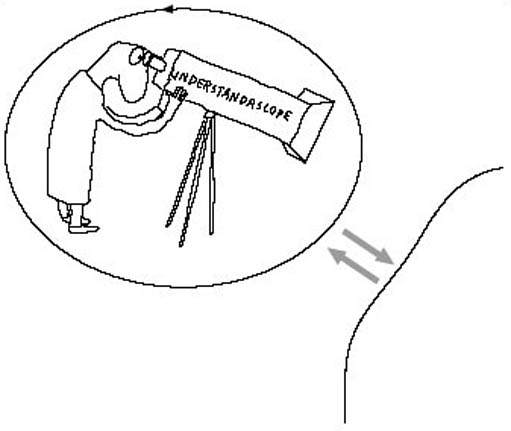6.6 Reviewing the juggler through the understandascope
At the beginning of Part 3 I invited you to consider through the lens of the understandascope (Figure 19) an ideal model of a systems practitioner juggling the four balls of being, engaging, contextualising and managing. By introducing material based on the biology of cognition when considering the B ball my invitation was to see the fusion of the observer and his or her understandascope into an autonomous unity. Thus is Figure 49 I have depicted the observer and their understandascope as a living system coupled to a medium or environment. The implications are that human beings are both biologically autonomous yet never independent of their context.

In terms of an ethics of practice, the advice I offered from Heinz von Foerster was to act to maximise the available choices. My claim was that systems practice was qualitatively different and that an aware practitioner had a greater array of choices at their disposal for managing complexity (Figure 48). By this stage you might be able to make an assessment of how many balls you have in the air, and whether you feel you have more choices at your disposal.
The metaphor of the juggler being the ideal practitioner is designed to convey concepts that some have found difficult in the past. The learning involved is of the type Isaacs (1993) says addresses the question: ‘What is leading me and others to have a predisposition to learn in this way at all? It is learning that opens enquiry into underlying “whys” and permits insight into the nature of a paradigm itself, not merely an assessment of the paradigm’. The limited literature on this type of learning suggests it is not easy. For example, Salner (1986) reports on the evaluation of a systems theory and methodology course for students in the USA in which otherwise mature and intelligent students could not grasp and apply systems concepts. It was concluded that systems thinking, when it does develop, emerges from a long period of personal experiences and interactions and from the testing of one's own mental models. Salner (1986) contends new ways of thinking require competence at an epistemic level.
You might be encouraged to know that research with former OU students shows many have benefited from their Systems course in a range of different ways (Maiteny and Ison, 2000). The overriding benefit, generally agreed by those involved in the research, was that systems thinking improves the capacity to recognise the validity of other people's points of view; to put oneself in their shoes. Further research shows that our students can put their learning into practice. In 2002 people who studied OU systems courses and have used systems thinking in their practice in the UK NHS were interviewed. Those interviewed came from a wide range of work roles in the NHS. Some of the comments included:
I just think the more people that do systems in the NHS the better. We'll all have a better understanding of what's going on. (Practice nurse)
Systems thinking helps predict where disasters are going to happen. (Planning patient care)
We had a particularly difficult situation with a patient causing significant managerial problems. So … we sat down and I described a [systems] model of trying to understand the issues and took my drawing. We still have the problem but what we now have is a management approach to the problem. (Managing patient care)
One of the things I've been able to facilitate for them is to ask them questions that makes them think about what it is they're doing. So they say ‘let's do streaming’. Well, what do you mean by streaming? I'm [using] Soft Systems Methodology … to get people to think about what's the mess they've got now, what's the ideal system and how can we bring those two things closer together. (Patient journey mapping)
Another respondent said:
If you were trying to equip people for managing who were not managers, like doctors and nurses, how would you do that quickly and effectively? It seems to me that giving them ‘tools for thought’ – systems thinking – is a good way of starting. Giving them that structure and giving them the language is helpful. Because … you can speed up.
